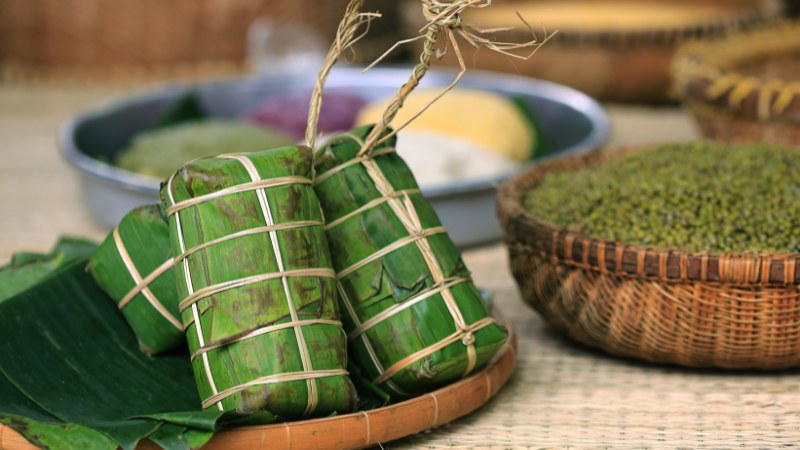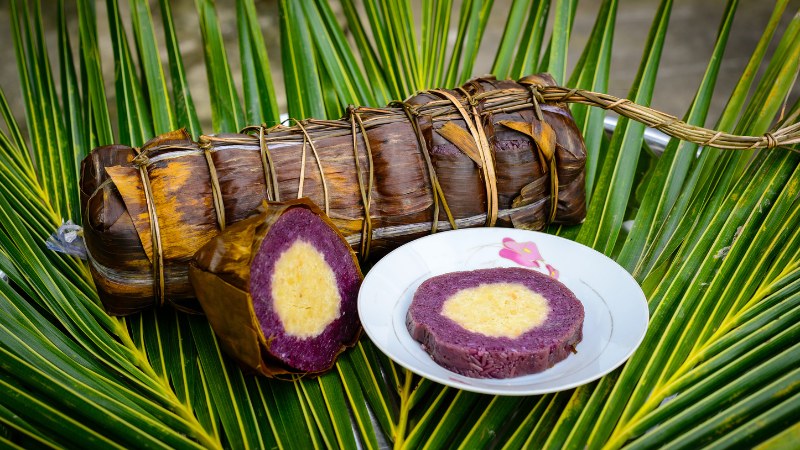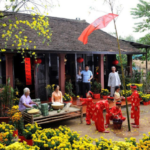If in the North on Tet holiday there is the traditional green square glutinous rice cake associated with the legend of “banh chung banh day” of the 18th prince of King Hung, Lang Lieu, symbolizing the round sky and square earth, then Tet cake in the South also has its own fascinating stories about its origin and significance.
According to Tet customs, the Tet cake is cooked on the night of the 30th of Lunar December. The whole family will gather around the pot of cake, creating a warm and prosperous atmosphere for the family reunion on Tet holiday.
During Tet, people in the South only make two types of Tet cakes: vegetarian Tet cake and savory Tet cake. The vegetarian Tet cake is offered to ancestors and spirits, while the savory Tet cake is consumed as a meal, served with pickled onions, pickled vegetables, and braised pork.
1 Origin of Tet cake on Tet holiday
Some cultural experts believe that the Tet cake used by people in the South on Tet holiday today is a product of the cultural exchange between the Vietnamese and Cham cultures, or it could be the inheritance of the values left by the previous generations. When the Vietnamese started to expand their territory to the South, due to the assimilation of the Cham cultural elements, including the belief in rice deity, the Vietnamese settlers later created the Tet cake as it is known today.
 Origin of Tet cake on Tet holiday
Origin of Tet cake on Tet holiday
In addition to the origin of the Tet cake as a product of cultural exchange, the ancestors also passed down legendary tales explaining the formation of the typical Tet cake, such as the story of King Quang Trung when he fought against the Qing army on Tet holiday and allowed his troops to rest.
A soldier offered the king a cylindrical cake wrapped in banana leaves, which the king found delicious and asked what kind of cake it was. The soldier replied that it was the kind of cake that his wife usually packed for him to eat along the way, and every time he ate it, he thought of his wife and their homeland.
Hearing this, King Quang Trung was deeply moved and ordered everyone to make and eat this kind of cake on Tet holiday, naming it Tet cake. This is considered the origin of the Tet cake in the traditional Tet holiday of Vietnam.
2 Why is it called Tet cake?
Just like its origin, even the name “Tet cake” has many explanations. As mentioned above, Tet cake is also known as “Banh Tet” due to the regional dialect of the people in the South.
Another explanation is that “tet” is an action to cut a piece of cake when eating this kind of cake. The eater will use a string to cut the cake into small pieces. Therefore, the local people call this type of cake “Tet cake” as it resembles the action of cutting the cake.
 Why is it called Tet cake?
Why is it called Tet cake?
3 Significance of Tet cake on Tet holiday
According to the ancient beliefs, all kinds of cakes and food used on Tet holiday have the meaning of remembering the ancestors and wishing for the warmth and abundance of the family. Tet cake, with its multiple layers of leaves wrapped around it, symbolizes the mother embracing her child, bringing the desire for the warmth and togetherness of the Vietnamese people on Tet holiday. Moreover, the green mung bean filling and the golden color of the cake represent the green color of the countryside, evoking the aspiration for a peaceful and prosperous life in the coming spring.
 Significance of Tet cake on Tet holiday
Significance of Tet cake on Tet holiday
The Tet cake, also known as Tet cake, may seem simple but it carries many meanings and wishes for a harmonious and prosperous family. Therefore, according to Tet customs, every family stays up late on the 29th and 30th of Tet to gather around the pot of cake. Children play and have fun, grandparents gather around the kitchen, and adults compete to make the cakes, creating a warm and prosperous atmosphere for Tet holiday.






































